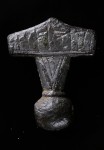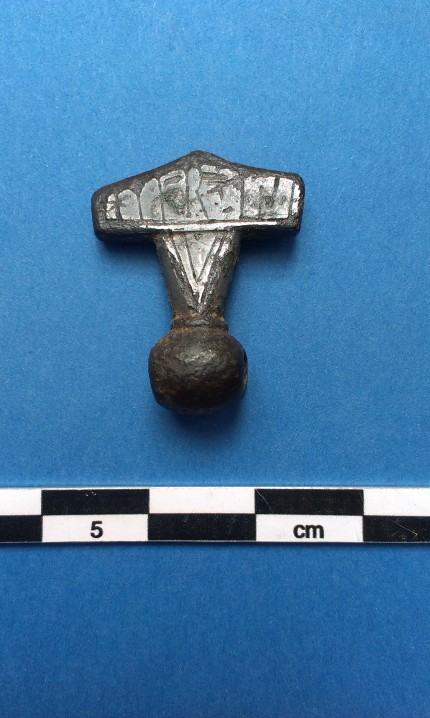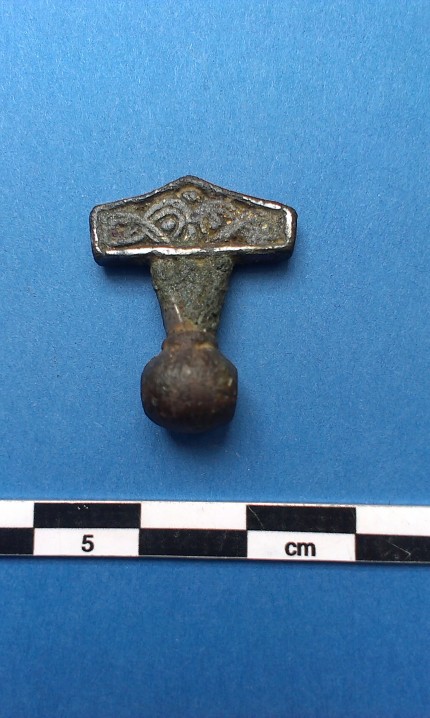 This spring, metal detectorist Torben Christjansen found a small amulet in Købelev on the Danish island of Lolland. Just one inch long and wide, the piece is in a shape known as Thor’s hammer, a design thought to invoke the protective power of Thor and his dwarf-forged hammer Mjolnir. About 1,000 of these Viking-era amulets have been discovered in Scandinavia, the UK, Russia and the Baltic countries, often unearthed in women’s graves. There has been some debate, however, on whether they were representations of Thor’s hammer, even stylized versions. Skeptics point out that the shaft is disproportionately short to be a hammer, and the head too symmetrical.
This spring, metal detectorist Torben Christjansen found a small amulet in Købelev on the Danish island of Lolland. Just one inch long and wide, the piece is in a shape known as Thor’s hammer, a design thought to invoke the protective power of Thor and his dwarf-forged hammer Mjolnir. About 1,000 of these Viking-era amulets have been discovered in Scandinavia, the UK, Russia and the Baltic countries, often unearthed in women’s graves. There has been some debate, however, on whether they were representations of Thor’s hammer, even stylized versions. Skeptics point out that the shaft is disproportionately short to be a hammer, and the head too symmetrical.
Christjansen reported the find as treasure trove to the local Museum Lolland-Falster where curators dated it to the 10th century. The amulet was cast in bronze and has traces of the silver or tin plating and gold plating that once adorned it. One side of the hammer’s head is decorated with interlacing pattern, the other side with a runic inscription seven characters long. This is the first Thor’s hammer amulet ever found inscribed with runes.


Because the runes were so small — three to seven millimeters high — and the surface corroded from the centuries it spent in the ground, the Museum Lolland-Falster curators sent the amulet to the National Museum of Denmark for their experts to decipher. Examining it under a microscope, museum runologist Lisbeth Imer was able to translate the inscription and it resolves the hammer question in the bluntest terms possible: the runes read “Hmar is x,” or in modern Danish “Hammer is” (the x isn’t a letter but a delimiter between two words). Translated into English the inscription simply says “This is a hammer.”
 There are two mistakes in the runes. The author left out the first a in “hammer” and flipped the S-rune backwards à la Toys-R-Us. These could have been errors of literacy or a function of the tiny space the writer had to inscribe. Even if his or her spelling was spotty, the rune carver would have derived status and prestige from being literate in a society that prized writing.
There are two mistakes in the runes. The author left out the first a in “hammer” and flipped the S-rune backwards à la Toys-R-Us. These could have been errors of literacy or a function of the tiny space the writer had to inscribe. Even if his or her spelling was spotty, the rune carver would have derived status and prestige from being literate in a society that prized writing.
The hammer wasn’t the only artifact Christjansen found on the site. He discovered pieces of silver needles and a matrix used to make brooches. These finds could indicate there was a jewelry-making workshop in the area. If so, the hammer could have been made locally. There are no plans currently for an archaeological investigation of the site. Christjansen will keep surveying the area with his metal detector, however, and Museum Lolland-Falster curators will be working with him going forward.